Building an orchid terrarium is amazingly fun. When you recreate a mini-habitat that simulates where orchids would live naturally, you’re rewarded with some of the most beautiful terrariums that exists: orchid terrariums.
Closed terrariums simulate a rainforest in terms of humidity, since the trapped air enters a repetitive cycle of condensation and evaporation. Orchids happen to love humidity. The natural consequence of loving orchids and loving terrariums is the creation of orchid terrariums.
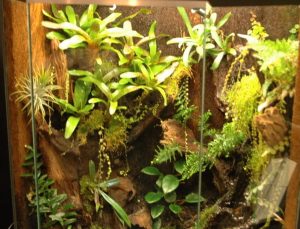
Building a terrarium that won’t die in a couple months is accomplished by grouping plants with similar growing conditions together.
Don’t think that you’ll grab a bunch of plants laying around, throw them into a glass vase and, voila, you’re done.Researching your plants to make sure that they’ll live well together is half the fun. Fun?? Yes! When you start elaborating a list of plants whose growing conditions are similar, you design a “natural landscape” that permits all them to live together.
What orchids are most suited for terrariums? Look for orchids that won’t grow more than the size or your open palm—miniature orchids. Out of that list, search for orchids that like high humidity if you are using a closed terrarium, and lower humidity if using an open terrarium.
One huge concept that I need to mention from the get-go: overall, orchids do not grow well in closed terrariums. I’ve only had success when building them if I used a large enough habitat, like an aquarium-sized tank and added a circulating fan. If you can, aim for an open terrarium or find a way to add additional airflow.
Those fancy images of orchid in a closed glass jar are amazing, but the orchid will not live in that kind of environment for long without outside air. The roots rot and the stem decays because orchids love humidity but also need to dry out, too. Yes, the majority live in the hot, humid rainforests, but in those environments, the air flow is pretty high.. Wind currents dry out the roots before nightfall. In a closed terrarium, air circulation does not happen.
So before attempting to make closed terrarium, buy a tiny computer fan and hook it up. Only then can you successfully maintain the terrarium with an orchid inside it. That being said, let’s dive in…
The most common miniatures are the same as the most popular orchids bought and sold in greenhouses. This might be because of popular demand, but don’t focus on only these. Some less common orchids are varieties that only come in miniatures, and that’s what we’ll focus on in this article. Before you go out and buy orchids off this list, let’s take a look and learn a little more about each one and how to care for it.
Most Common Miniature Orchids
- Cattleya
- Dendrobium
- Laelia
- Oncidium
- Phalaenopsis
Best Miniature Orchids for Closed Terrariums
- Dracula
- Lepanthes
- Masdevallia
- Platystele
- Tolumnia
1. Masdevallia Orchids
Masdevallia orchids love high humidity, from 80 to 100%. This is why they’re the perfect species to grow in a closed terrarium.
They don’t like much light, being on the low-light category if 1000 to 1200 foot candles. This means that if you get a Masdevallia in your terrarium, don’t place the terrarium in direct sun, like on a window sill.
It needs bright light, but the sun rays that hit the glass directly will heat the air inside of the glass and become a magnifying glass, burning the leaves.
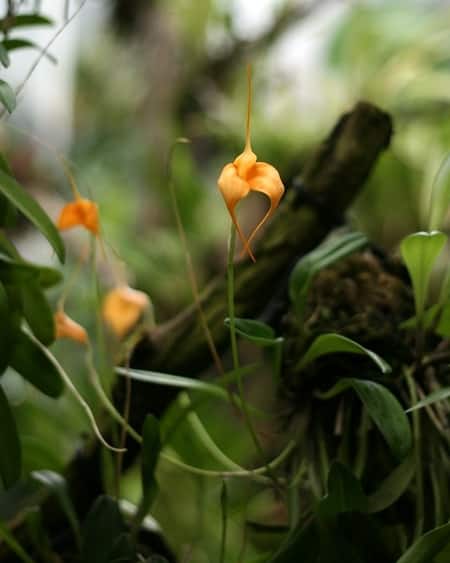
Masdevallias prefer to be planted in only sphagnum and perlite, but not bark.
This is because they don’t have pseudobulbs and can’t hold water, so they’ll dry out more often.
The sphagnum will not allow humidity to totally evaporate, so their roots will be happier.
Bark is too hard of a structure for their fine roots.
If you’re looking for Masedvallias, try Andy’s Orchids (Affiliate Link) on Amazon. This picture is of the Masdevallia rolfeana.
He specializes in terrarium plants and I found his prices to be very reasonable.
This is another Masdevallia, called Masdevallia amibilis. It is also from Andy’s Orchids (Affiliate Link).
The colors on this one are fascinating, and put on a show for themselves.
This last option (that I’ll suggest) is called the Masdevallia sofronitis. It’s delicate flowers are so charming.
Last time I checked, this one was a little more costly than the first two, but still well worth it (Affiliate Link).
2. Dracula Orchids
Dracula orchids are much like Masdevallias in their care. They are so similar that it was only in 1978 that Draculas separated from the Masdevallia species and got their own distinct classification.
Curiously enough, the name Dracula wasn’t from the horror movie or classic literature, but from the latin word “dragon”. Two prolongations on each side of the flower resemble the side beards that are usually drawn on Chinese dragon pictures. A lot of the orchids within the 90 categorized in the Dracula species have black dots which resemble eyes. Some of these Draculas are even called monkey orchids for that reason.
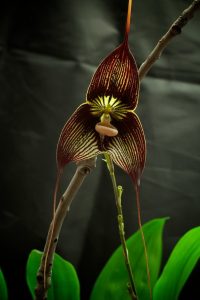

As to their care, the same light and humidity requirements apply, but one thing I didn’t mention was the temperature.
Draculas are more adept to cooler temperatures, so if you grow this one in your terrarium, definitely keep it away from direct sun.
By cooler temperatures, don’t let your Draculas reach over 68ºF (20º C) in the day time. At night, drop the temperature in the room to 58º F (14º C). You might need to direct a cool-air fan directly at the glass to achieve this drop, but the main important thing is that the glass (and the air inside it) never gets too hot.
This specific Dracula Orchid is called Dracula navarroorum (Affiliate Link ). It will need a little more water than the others.
). It will need a little more water than the others.
3. Lepanthe Orchid
A good reason to keep a Lepanthes orchid is not only for its flower, the leaves on this orchid are fascinating. The flowers are actually quite tiny, (0.3 inches or 8mm) and if there was a “mini-mini-mini” classification, these would win the prize.
They only stay in bloom for an extremely short time, one flower at a time, but in succession. One grows, dies, then another blooms. They also don’t have a resting period or go into dormancy.
With extremely colorful blossoms, usually are bright red or multi-colored, Lepanthes develop a visual contrast from the dark green-veined leaf.
When placing Lepanthes in your terrarium, keep it towards the back or under a log. Why? These prefer full shade, more so than the Masdevalias and the Draculas. Since their foliage is their main attraction, with highly-developed and intricate patterns, these make a perfect “filler” plant. They can tolerate up to 2100 foot candles, but thrive in less.
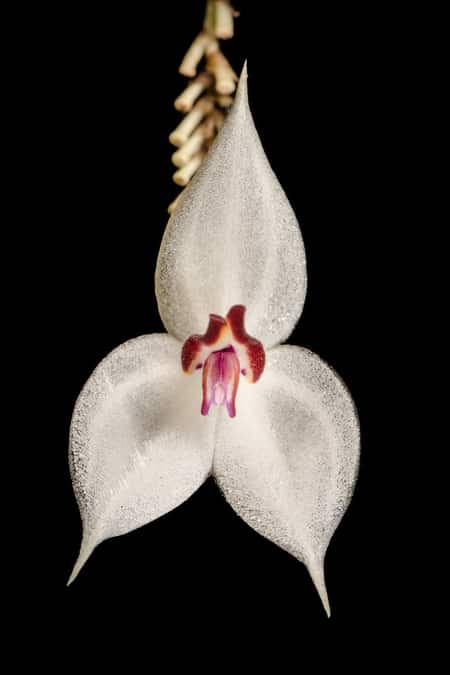
Lepanthes are high watering plants, just like the other two mentioned above.
They are most commonly found planted in sphagnum moss and perlite because of their high humidity requirements (60 to 80% humidity).
As for temperatures, Lepanthes do well in cooler to warm temperatures, and can tolerate higher temperatures than the Draculas do.
As for fertilizer, don’t use ¼ of the recommended does: use 1/8. This goes for all the miniature orchids that are listed in this article.
I do not have a Lepanthe orchid, just because I personally prefer larger flowers. They are cute in their own way, so I can’t not indicate it just because it’s not my favorite.
If you want an idea of what the price is, check out this Lepanthe auriculata, (Affiliate Link) .
.
4. Platystele Orchids
Platystele orchids, (with 95 catalogued species in the genus) are good for the foliage, since their flowers are extremely tiny: 0.1 inches (2.5mm). The good part is that they grow in bundles, unlike the Lepanthes, which is a single bloom.
These cool to warm growing orchids thrive in temperatures around
60 to 90°F (15 to 33° C) so they do well indoors.
The ideal temperature is 80º F (26º C) during the day, dropping to
64º F (17º C) at night.
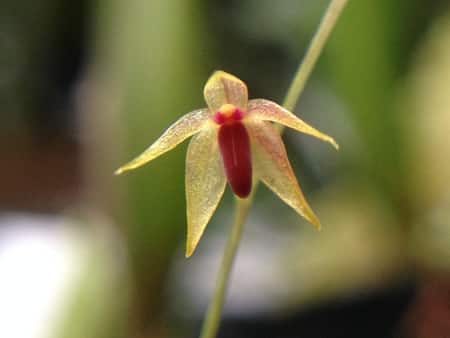
5. Tolumnia Orchids
My favorites!!! Tolumnias are “mini-oncidiums” (that’s what I call them.) In fact, they were part of the Oncidium genus for years, until they became their separate genus in 1986.
For beautiful flowers in your terrarium, try these orchids, because once the flower and blossom into gorgeous mini-oncidiums, they will bloom again. You shouldn’t be messing around in the terrarium anyway, but resist the temptation to cut back the flower spike after it blooms. If it’s well-nourished, you can expect two blooms, one right after another.
Tolumnia orchids are the hardest of these to grow in terrariums and tend to get root rot quickly. Keep them away of the mister and always check the roots.
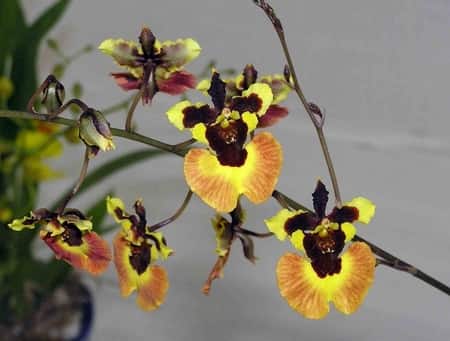
Of all the orchids mentioned above, Tolumnias need to be grown in less humidity, 50 to 70%.
So if none of the mini-orchids hit that soft-spot in your heart, try tolumnias with other less humid orchids, like Phaalenopsis. Tolumnias and Phals grow great together, since their conditions are extremely similar.Tolumnias prefer to be mounted on bark than potted in sphagnum moss, so if you are planning on using a tree or log, this is the perfect plant for that. Mount it higher up, toward the top of the terrarium, so the flowers can spill down.
Tolumnias will be the biggest of the plants on this list, and can be potted into 3 to 4 inch pots (7 to 10 cm). So when transplanting them into your terrarium, keep in mind they do grow.
This is a Oncidium (Tolumnia) variegatum, (Affiliate Link )that is also suitable for terrariums, if you keep an eye on the humidity.
)that is also suitable for terrariums, if you keep an eye on the humidity.
The temperature requirements on these are a little higher though, so don’t plant them with the others listed in this article.
These are a good suggestion for starters, and can be found online to buy at orchid stores. If you want to try others, take a look at:
Bulbophyllum,
Corybas (or spider orchids),
Gastrochilus (which look like tiny Phaalenopsis orchids),
Sarcochilis,
Cystorchis Variegata (which is another larger type of Jewel Orchid),
Goodyera (rattlesnake plantain),
Nephelaphylum,
Pluerothallis,
Chiloschista,
Anoectochilus (also good for foliage with intricate leaf patterns),
Vrydagzynea,
Trichosalpinx chamaelepanthes,
and Stellis argentata.
No matter what orchids you use in your terrarium, be sure to do proper research on it, and buy other orchids that go into that same description of light, humidity, watering, fertilizer and other similar conditions.
It’s better to have a smaller terrarium that thrives, than a larger one with several different climatic preferences, which is doomed to death.
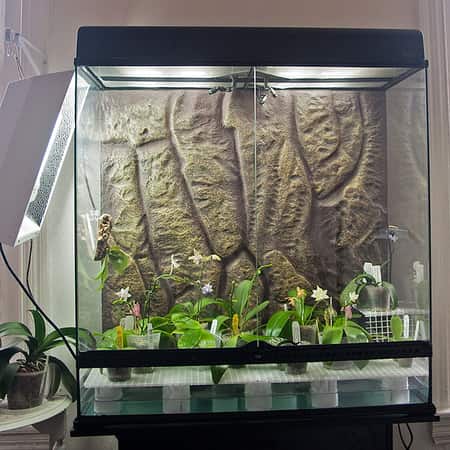
If you want to see more pictures of these orchids, head over to my Pinterest page, where I have more than 200+ pictures of orchids separated by categories. There you’ll also find more pictures of terrariums, which aren’t quite as complex as the ones here. I also have a video about mounting a Dracula and Masdevalia terrarium, which you can see on this page, or directly on YouTube, by clicking here.
where I have more than 200+ pictures of orchids separated by categories. There you’ll also find more pictures of terrariums, which aren’t quite as complex as the ones here. I also have a video about mounting a Dracula and Masdevalia terrarium, which you can see on this page, or directly on YouTube, by clicking here.
Don’t Stop Learning!
If you want to be included in more information and get a 14-page fertilization guide, please sign up for my newsletter. I don’t spam, but send emails out bi-monthly with some curious topics of interest. If you want more information, click here to go to a specific page on this website where I explain it more in detail.

Also, if you are looking for an orchid journal to keep your notes specifically about orchid care, check out my 2 solutions for that on this page. If note-keeping isn’t your thing, then there is a free excel spreadsheet that you can download. Click here for more information on how to do that.
If you subscribe to my newsletter, I will send you a 14-page guide on the main tips of orchid fertilizer. It is downloadable and you can print it out on your computer. I designed the guide to double up as a coloring book, just to make it fun.
I hope this list gives you a good starting point in gathering the right orchids for your closed terrarium. If you have any questions or comments, please leave them in the box below.








Really pleased I came across your article this evening, as have managed to talk the other half to make a large tank into my orchid growing area. Rather than a 3rd fish tank in the living room. Looking forward to reading and learning more!